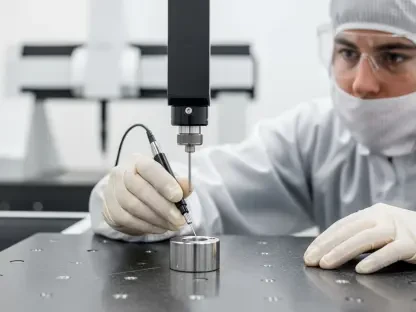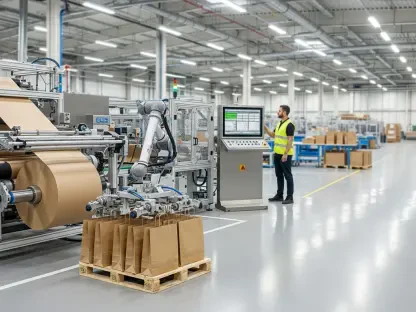In a world increasingly driven by industrial innovation and infrastructural expansion, the global market for Maleic Anhydride stands as a pivotal player, poised for significant growth over the coming decade, with a valuation of approximately $4.4 billion in 2024. This essential organic compound is projected to climb to an impressive $6.7 billion by 2035, fueled by a steady Compound Annual Growth Rate (CAGR) of 4.00% from the current year through 2035. Known for its critical role in producing unsaturated polyester resins (UPR), Maleic Anhydride supports a range of industries, from automotive to construction, by enabling the creation of durable composite materials. As demand surges in key sectors and regions, understanding the dynamics of this market becomes vital for stakeholders aiming to capitalize on emerging opportunities. This analysis delves into the forces propelling growth, the challenges that loom on the horizon, and the strategic segments shaping the future of this versatile chemical compound.
Driving Forces Behind Market Expansion
The momentum behind the Maleic Anhydride market’s growth is largely tied to the escalating demand for unsaturated polyester resins, which are indispensable in crafting fiberglass-reinforced polymers for various applications. Industries such as automotive, construction, and wind energy are at the forefront of this surge, with each sector leveraging UPR for its strength and versatility. In the automotive realm, the rising incidence of vehicle damage globally has amplified the need for repair materials, directly boosting UPR consumption. Similarly, the construction industry, especially in developing economies, relies heavily on these resins for creating robust materials used in infrastructure projects. This consistent demand across critical end-use sectors underscores the market’s resilience and potential for sustained growth, as industrial activities continue to expand worldwide, necessitating innovative and durable material solutions.
Another significant driver of this market’s trajectory is the rapid industrialization in the Asia Pacific region, which is anticipated to register the highest growth rate during the forecast period. Countries like China, India, and Indonesia are witnessing unprecedented construction spending, supported by favorable government policies that encourage infrastructural development. This regional boom is complemented by a growing appetite for plasticizers and agricultural chemicals, both of which utilize Maleic Anhydride as a key component. The confluence of domestic demand and policy support positions Asia Pacific as a powerhouse, steering global market trends. Additionally, the region’s focus on expanding manufacturing capabilities further cements its role as a critical hub, influencing supply chains and production strategies on an international scale.
Market Segmentation and Material Preferences
Delving into the segmentation of the Maleic Anhydride market reveals a clear preference for certain raw materials and applications that dominate the landscape. The market is primarily categorized by raw materials into n-butane and benzene, with n-butane emerging as the preferred choice due to its cost-effectiveness and environmental advantages. Unlike benzene, n-butane offers higher productivity and a simpler production process, making it a go-to option for manufacturers. This preference is particularly pronounced in sectors like construction and transportation, where the demand for sustainable and efficient materials is on the rise. The shift toward n-butane reflects a broader industry trend of aligning with environmental responsibility, as companies strive to minimize their ecological footprint while meeting robust market needs.
When examining applications, the unsaturated polyester resin segment holds the largest share, driven by its integral role in producing thermoset materials. These materials, when combined with fillers and cured, form strong composites used in pipelines, chemical storage tanks, and various other industrial applications. The durability and adaptability of UPR make it a cornerstone in industries requiring high-performance materials, thus sustaining its dominance in the market. Beyond UPR, Maleic Anhydride also serves as a precursor for food preservatives, pharmaceuticals, and agricultural products, showcasing its versatility. This wide applicability ensures a steady demand across diverse sectors, reinforcing the compound’s significance in industrial processes and encouraging innovation in its usage.
Challenges and Emerging Opportunities
Despite the optimistic growth projections, the Maleic Anhydride market faces notable challenges that could temper its expansion. The increasing adoption of hybrid vehicles and the push toward battery price parity in the automotive sector are reducing reliance on traditional materials like UPR, as manufacturers pivot to alternative solutions. Additionally, stringent government regulations on emissions and chemical usage pose hurdles, compelling companies to adapt to tighter standards. These factors collectively signal a potential shift in market dynamics, where traditional demand drivers may face constraints. Navigating these regulatory and technological shifts will be crucial for industry players aiming to maintain their competitive edge in an evolving landscape.
On the flip side, the market is ripe with opportunities that promise to offset some of these challenges. The rising demand for derivatives like 1,4-butanediol (1,4-BDO) opens new avenues for growth, as does the commercialization of bio-based Maleic Anhydride, which aligns with global sustainability goals. Emerging economies continue to present fertile ground for expansion, with evolving income streams and megatrends in end-use industries driving demand. These opportunities highlight the potential for innovation, particularly in developing sustainable alternatives and tapping into underrepresented markets. By focusing on research and development, companies can harness these prospects to create value and ensure long-term growth in a competitive environment.
Future Pathways and Strategic Insights
Reflecting on the journey of the Maleic Anhydride market, it becomes evident that steady progress is underpinned by robust demand from pivotal industries like construction and automotive. The regional dominance of Asia Pacific plays a crucial role, as industrial expansion and supportive policies fuel market dynamics over the years. Challenges such as regulatory pressures and shifts in automotive technology test the resilience of market players, yet the industry adapts by exploring new material preferences and applications. This adaptability is key to maintaining momentum despite headwinds, showcasing the market’s capacity to evolve with changing global needs.
Looking ahead, stakeholders should prioritize innovation in bio-based alternatives to address environmental concerns and meet regulatory demands. Strategic investments in emerging markets can further unlock growth potential, while collaboration with end-use industries will ensure alignment with evolving requirements. Emphasizing sustainable practices and diversifying application areas will be essential steps in navigating future uncertainties. By adopting these forward-thinking approaches, the industry can build on past achievements to secure a prosperous trajectory through 2035 and beyond.









